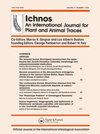First Report: Trace Fossil Assemblage Ptychoplasma (P. excelsum, P. vagans), Dendroidichnites (D. irregulare), Ctenopholeus (?C. kutcheri) and Bergaueria (B. hemispherica) in the Cretaceous Rocks of Bagh Formation, Mainland Gujarat, India
IF 2
4区 地球科学
Q4 PALEONTOLOGY
Ichnos-An International Journal for Plant and Animal Traces
Pub Date : 2019-02-04
DOI:10.1080/10420940.2018.1561446
引用次数: 4
Abstract
Abstract This report documents the discovery of repichnia trace fossils Ptychoplasma (P. excelsum and P. vagans) and Dendroidichnites (D. irregulare); the fodichnia traces ?Ctenopholeus (?C. kutcheri) and cubichnia traces Bergaueria (B. hemishperica) from silty limestones of the Cretaceous Bagh Formation. These trace fossils have significant implications for the depositional facies and the paleo-environmental interpretations of the Bagh Formation, which have long been debated. Previously identified traces of Protovirgularia were also found in association with the newly discovered trace fossils, indicating the coexistence of both wedge and cleft-foot bivalves. The western area of the mainland Gujarat is known for its abundance and diversity of trace fossils. The trace fossil bearing Cretaceous rocks in the region occur as thin irregular detached patches and linear outcrops. Previous studies documenting trace fossil assemblages from the Bagh Formation characterised them as a combination of dwelling, feeding and locomotion forms, with the stratigraphic unit becoming less fossiliferous westward. Trace fossils in this formation have been studied and described by many workers in the surrounding areas; however, ichnofossils described in this study are new to the Bagh Formation in this area. These trace fossils were observed on recently exposed outcrops along road cuts associated with new road construction from Khasra to Mogra village around Kadipani in Mainland Gujarat.首次报告:微量化石组合Ptychoplasma (P. excelsum, P. vagans), Dendroidichnites (D. irregulites), Ctenopholeus (?C。kutcheri)和Bergaueria (B. hemispherica)在印度古吉拉特邦大陆Bagh组白垩纪岩石中
摘要:本文报道了在中国发现的棘虫(repichnia)微量化石:Ptychoplasma (P. excelsum和P. vagans)和Dendroidichnites (D. irregulare);fodichnia的痕迹? ctenopholus (?C。kutcheri)和cubichnia在白垩纪Bagh组粉质灰岩中发现Bergaueria (B. hemishperica)。这些微量化石对巴格组沉积相和古环境的解释具有重要意义,这是长期以来争论的问题。先前发现的原virgularia的痕迹也与新发现的痕迹化石相关联,表明楔足和裂足双壳类动物共存。古吉拉特邦大陆的西部地区以其丰富多样的化石遗迹而闻名。区内白垩系微量化石岩石呈薄而不规则的脱落斑块和线状露头。先前的研究记录了巴格组的化石组合,将它们描述为居住、觅食和运动形式的结合,地层单位向西的化石较少。这一地层的痕迹化石已被周围地区的许多工人研究和描述;然而,本研究描述的鱼化石在该地区的Bagh组是新的。这些痕迹化石是在古吉拉特邦大陆卡迪帕尼附近的Khasra到Mogra村的新道路建设相关的道路切割处最近暴露的露头上观察到的。
本文章由计算机程序翻译,如有差异,请以英文原文为准。
求助全文
约1分钟内获得全文
求助全文
来源期刊
CiteScore
2.50
自引率
12.50%
发文量
0
审稿时长
>12 weeks
期刊介绍:
The foremost aim of Ichnos is to promote excellence in ichnologic research. Primary emphases center upon the ethologic and ecologic significance of tracemaking organisms; organism-substrate interrelationships; and the role of biogenic processes in environmental reconstruction, sediment dynamics, sequence or event stratigraphy, biogeochemistry, and sedimentary diagenesis. Each contribution rests upon a firm taxonomic foundation, although papers dealing solely with systematics and nomenclature may have less priority than those dealing with conceptual and interpretive aspects of ichnology. Contributions from biologists and geologists are equally welcome.
The format for Ichnos is designed to accommodate several types of manuscripts, including Research Articles (comprehensive articles dealing with original, fundamental research in ichnology), and Short Communications (short, succinct papers treating certain aspects of the history of ichnology, book reviews, news and notes, or invited comments dealing with current or contentious issues). The large page size and two-column format lend flexibility to the design of tables and illustrations. Thorough but timely reviews and rapid publication of manuscripts are integral parts of the process.

 求助内容:
求助内容: 应助结果提醒方式:
应助结果提醒方式:


